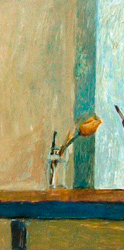Camouflage
I am looking at Radek Zielonka’s paintings and the first association that comes to mind is the philosophy of Morandi, who – living in the Italian city of Pesaro – painted everything he had at home or could see though the window… Another thing that Morandi and Radek have in common is their great amount of insight when observing their surroundings, the tendency to simplification, the search for perfection in composing objects – items of everyday home use – in their mutual arrangement and against the lines of the table, floor and carpet. It’s hard to say that it’s a purely studious observation. It’s more of a visual taming of an object as an individuality of untamed nature and a projection without blatancy or without tormenting the audience with details. Here, real objects or a landscape are the source of inspiration for further synthesizing, subtracting. While painting a specific chair or landscape Radek seems to isolate it and, at the same time, use form and colour to create only its general outline, idea or atmosphere. He is preparing his own visual painting dictionary – a collection of mysterious rebuses. Detail is non-existent, only the feeling of some presumably suspended plot. And then, looking at the painting we say: a chair, a submarine, a field.
He chooses the form with utmost care since he uses it later as an abstract plan to construct the surface of the painting where only colours of particular areas matter. Then comes an intense search of their sublime definition – often polytonal and multilayered. The matter of each area may look textural or quivering, but the paintings appear to be simple, decided and synthetic. Reality is often a mere pretext to plan colours on the canvas. Quite similarly to geometrical compositions of Constructivists, because Constructivists – by definition interested in expressing themselves through shape – attached great importance to colour. And Radek has also got such a penetrating attitude to colour. In his simple forms, in the areas assigned to particular parts of the painting, colour is so strong that it looks as if the artist had to dig down really deep to get it. Sometimes it’s so dark and nocturnal that it needs some enlivenment, a fluorescent spot – just like an animal wearing camouflage colours that opens a glittering eye to lure its victim or call in a friend. It’s also the search for a focal point, balancing the dark composition with a single and sharp supporting point. For Radek balance, harmony is absolutely vital. If painting – a gesture of hand and the rest of the whole enterprise – just like handwriting represents man’s soul, from Radek’s paintings, even without knowing him personally, I can read that he is a guy exceptionally sensitive to beauty, independent.
A non-conformist, but in search of harmony in authority. Selective and precise in defining what he likes. He thinks timelessly. For him the lack of precise specification means freedom.










